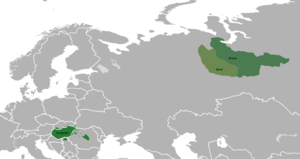This article includes a list of general references, but it lacks sufficient corresponding inline citations. (December 2019) |
| Ugric | |
|---|---|
| Ugrian | |
| Geographic distribution | Hungary and Western Siberia |
| Linguistic classification | Uralic
|
| Subdivisions | |
| Language codes | |
| Glottolog | None |
 The Ugric languages | |
The Ugric or Ugrian languages (/ˈjuːɡrɪk, ˈuː-/[1] or /ˈjuːɡriən, ˈuː-/[2]) are a branch of the Uralic language family.
Ugric includes three subgroups: Hungarian, Khanty, and Mansi. The latter two have traditionally been considered single languages, though their main dialects are sufficiently distinct that they may also be considered small subfamilies of three to four languages each. A common Proto-Ugric language is posited to have been spoken from the end of the 3rd millennium BC until the first half of the 1st millennium BC, in Western Siberia, east of the southern Ural Mountains. Of the three languages, Khanty and Mansi have traditionally been set apart from Hungarian as Ob-Ugric, though features uniting Mansi and Hungarian in particular are known as well.
The name Ugric is derived from ugry (угры), a Russian exonym of the Magyars (Hungarians) and the northern Russian region of Yugra. A connection between these words was first suggested in the beginning of 16th century. However, according to István Vásáry the etymological connection between these two words has not been verified, and the name Ugric is based on a folk etymology.[3]
- ^ "Ugric". Merriam-Webster.com Dictionary. Merriam-Webster.
- ^ "Ugrian". Merriam-Webster.com Dictionary. Merriam-Webster.
- ^ Vásáry, István (1982). "The 'Yugria' Problem". In Róna-Tas, András (ed.). Chuvash studies. Bibliotheca orientalis hungarica. Budapest: Akadémiai kiadó. ISBN 978-963-05-2851-1.